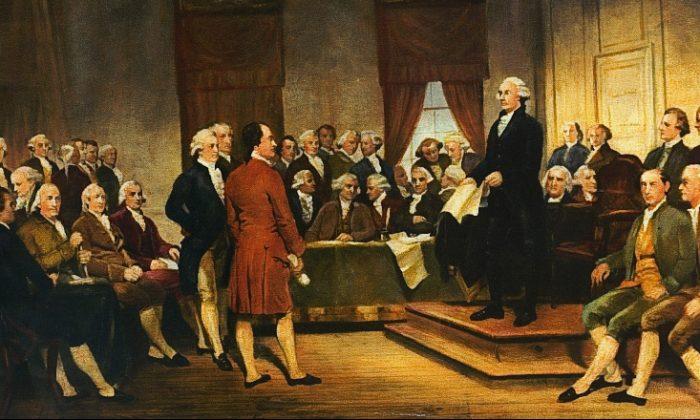Widespread public dissatisfaction with the federal government has sparked interest in recalibrating the system.
One obvious way to recalibrate is by amending the U.S. Constitution. Historically, amendments have proven to be powerful vehicles for reform. Americans have used constitutional amendments to protect minority rights, guarantee women the vote, enact the Bill of Rights, overrule the Supreme Court, limit the president to two terms, and abolish slavery in states not covered by President Lincoln’s Emancipation Proclamation.
When the Constitutional Convention met in Philadelphia in 1787, the delegates decided early on that if their new Constitution were to last, there had to be an amendment procedure. In the years immediately previous, several states had adopted constitutions without any way of amending them. This proved to be a major mistake.
For example, South Carolina’s first constitution, adopted in 1776, had no provision for alteration, and, within two years, the entire document had to be scrapped. The Constitutional Convention delegates also understood that they had to abandon the Articles of Confederation partly because its amendment method was almost impossible to use.
There were at least four reasons the framers wanted the Constitution to be amendable. First, they recognized they might make drafting mistakes that needed correction later. Second, officials might abuse their power, and amendments could limit or end those abuses. Third, amendments could resolve disagreements over how to interpret some parts of the Constitution. Finally, conditions might evolve over time in ways of calling for change in the constitutional rules.
The framers were right. As matters have turned out, Americans have adopted amendments for all four reasons. For example, the 12th Amendment corrected a drafting omission in the original Constitution. The first 10 amendments—the Bill of Rights—were adopted partly to forestall abuses and partly to clarify the limits on federal power. Several amendments have addressed state abuses of power. The 11th Amendment overruled an erroneous Supreme Court interpretation. The 20th Amendment, which moved up Inauguration Day, was approved after modern transportation technology shortened the time needed to travel to the nation’s capital. The 19th Amendment—guaranteeing women the vote—was motivated partly by fairness. But it also reflected a social change: Advances in household technology and in medicine (birth control and longer female life expectancy) rendered women’s participation in politics far more practical than it had been in 1787.
Any well-drafted constitution contains an amendment procedure. When the people ratify (approve) the document, they approve the amendment procedure as part of the package. We can alter a constitution only by following the steps outlined in the document itself.
Generally, the amendment procedure is much more difficult and time-consuming than merely passing a law. This is to assure that the people have a chance to thoroughly examine the measure over time. It also assures that a strong popular majority agrees.
No constitutional amendment should be merely the result of a momentary impulse. During the 1970s, activists promoted what they called an “Equal Rights Amendment” (ERA). Because the ERA supposedly would further woman’s equality, initially it was very popular. It quickly sailed through Congress and through many state legislatures.
Then people began to notice problems. The measure was poorly drafted. It might have all kinds of unintended consequences. It was also a huge transfer of power to unelected judges from democratically elected lawmakers. Because the amendment process took time and required several different steps, the people had a chance to think things over. They eventually defeated the ERA.
Thus, a good amendment process includes several steps. At the state level, there generally are at least three: First, the sponsor presents a draft amendment to state legislative attorneys for review. The state attorneys may suggest or even mandate stylistic changes. Second, the amendment is formally proposed by the legislature or by a popular petition signed by large numbers of citizens. Third, the public votes on whether to ratify. Usually, ratification requires approval only by a popular majority, but in some states, a super-majority is necessary.
On the federal level, the steps for an amendment are outlined in Article V of the Constitution. There are two ways to propose an amendment. One way is for two-thirds of each house of Congress to vote for it. The other is for two-thirds of the state legislatures (34 of 50) to demand a meeting of state delegations that the Constitution calls a “convention for proposing amendments,” which decides whether to propose one or more amendments.
Thus far, a convention for proposing amendments hasn’t been held, and only Congress has proposed amendments. However, we know how a convention for proposing amendments would work, because similar meetings of states have been common in U.S. history. (The most recent was held in 2017 in Phoenix.) Unfortunately, special interest groups opposing amendments have thwarted the state-proposal method by spreading misinformation about it. As a result, no amendment has been proposed for several decades because Congress isn’t interested in reform.
After Congress or a convention of states proposes an amendment, Congress decides on a “mode of ratification.” This means Congress may opt to send the proposal either to state legislatures or to democratically elected state conventions. Both methods have been used.
Finally, the state legislatures or conventions decide whether to ratify. The proposal becomes an amendment only if three-fourths of the states (now 38 out of 50) agree.





